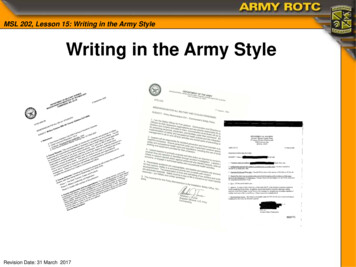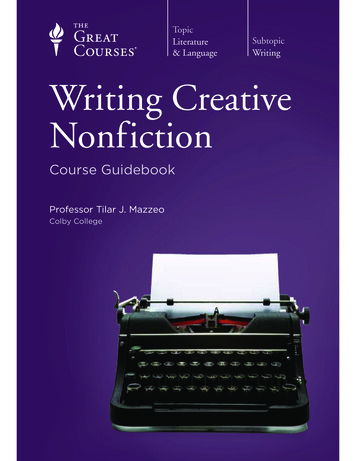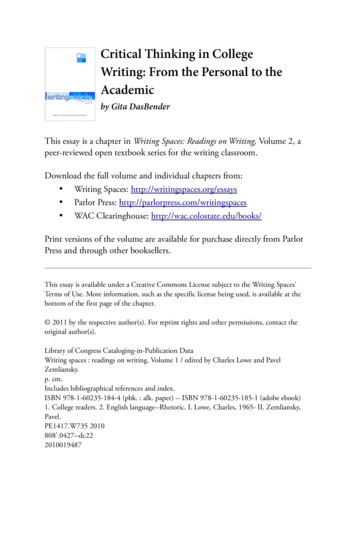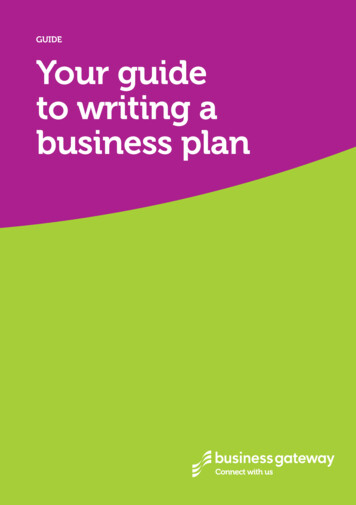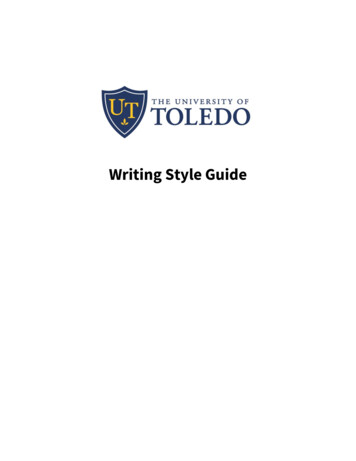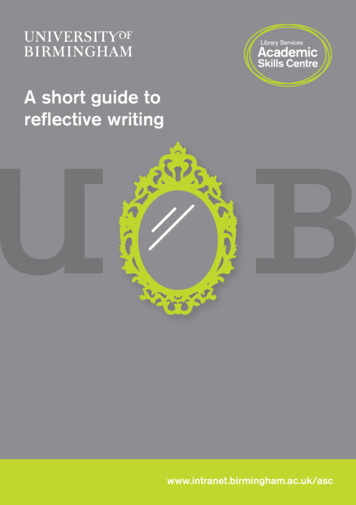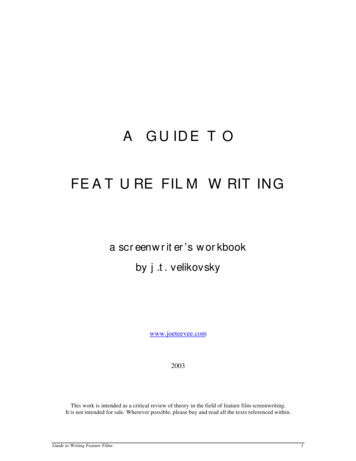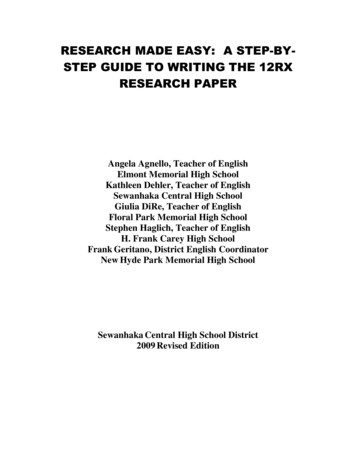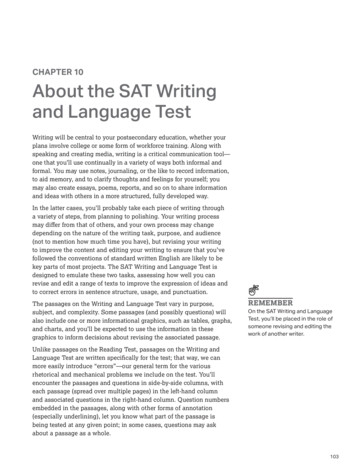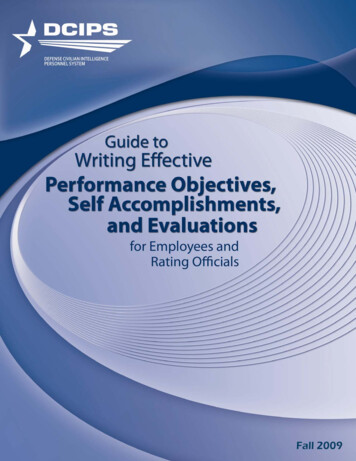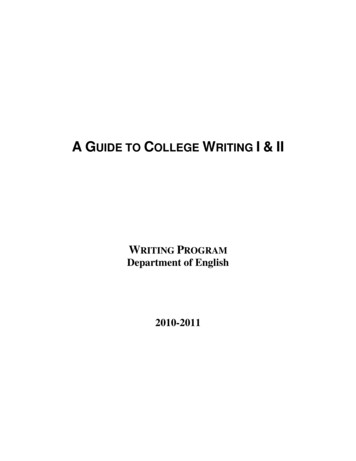
Transcription
A GUIDE TO COLLEGE WRITING I & IIWRITING PROGRAMDepartment of English2010-2011
ii
CONTENTSIntroductionAcknowledgements . . . . . . . . . . . . . . . . . . . . . . . . . . . . . . . . . . . . . . . . . . . . . . . . .Introduction . . . . . . . . . . . . . . . . . . . . . . . . . . . . . . . . . . . . . . . . . . . . . . . . . . . . . . .Signature page for Tier I Course . . . . . . . . . . . . . . . . . . . . . . . . . . . . . . . . . . . . . . .Signature page for Tier II Course . . . . . . . . . . . . . . . . . . . . . . . . . . . . . . . . . . . . . .1357The Writing Program at Kent State UniversityWriting Program Office. . . . . . . . . . . . . . . . . . . . . . . . . . . . . . . . . . . . . . . . . . . . . .9College WritingPlacement Guide . . . . . . . . . . . . . . . . . . . . . . . . . . . . . . . . . . . . . . . . . . . . . . . . . . . 11Core Courses . . . . . . . . . . . . . . . . . . . . . . . . . . . . . . . . . . . . . . . . . . . . . . . . . . . . . . 12Composition Courses . . . . . . . . . . . . . . . . . . . . . . . . . . . . . . . . . . . . . . . . . . . . . . . 13Tier I - College Writing I (11011) . . . . . . . . . . . . . . . . . . . . . . . . . . . . . . . . . . . . . . 14Introduction to College Writing S (11001) andCollege Writing I S (11002). . . . . . . . . . . . . . . . . . . . . . . . . . . . . . . 14Goals and Objectives for Tier I . . . . . . . . . . . . . . . . . . . . . . . . . . . . . . . . . . 15Requirements for Tier I . . . . . . . . . . . . . . . . . . . . . . . . . . . . . . . . . . . . . . . . 16Tier II - College Writing II (21011) . . . . . . . . . . . . . . . . . . . . . . . . . . . . . . . . . . . . . 16Goals and Objectives for Tier II . . . . . . . . . . . . . . . . . . . . . . . . . . . . . . . . . 17Requirements for Tier II . . . . . . . . . . . . . . . . . . . . . . . . . . . . . . . . . . . . . . . 18College Writing in the Department of Pan-African Studies . . . . . . . . . . . . . . . . . . . 19English as a Second Language Center . . . . . . . . . . . . . . . . . . . . . . . . . . . . . . . . . . 19Academic WritingWhat is Good Academic Writing? . . . . . . . . . . . . . . . . . . . . . . . . . . . . . . . . . . . . . .The Writing Process. . . . . . . . . . . . . . . . . . . . . . . . . . . . . . . . . . . . . . . . . . . . . . . . .Invention Activities . . . . . . . . . . . . . . . . . . . . . . . . . . . . . . . . . . . . . . . . . . . . . . . . .Freewriting . . . . . . . . . . . . . . . . . . . . . . . . . . . . . . . . . . . . . . . . . . . . . . . . .Looping . . . . . . . . . . . . . . . . . . . . . . . . . . . . . . . . . . . . . . . . . . . . . . . . . . . .Listing . . . . . . . . . . . . . . . . . . . . . . . . . . . . . . . . . . . . . . . . . . . . . . . . . . . . .Map Clustering . . . . . . . . . . . . . . . . . . . . . . . . . . . . . . . . . . . . . . . . . . . . . .Writing Revision . . . . . . . . . . . . . . . . . . . . . . . . . . . . . . . . . . . . . . . . . . . . . . . . . . .Key Terms in the Writing Process . . . . . . . . . . . . . . . . . . . . . . . . . . . . . . . . . . . . .Using Rhetorical Appeals . . . . . . . . . . . . . . . . . . . . . . . . . . . . . . . . . . . . . . . . . . . .Logical Fallacies . . . . . . . . . . . . . . . . . . . . . . . . . . . . . . . . . . . . . . . . . . . . . . . . . . .2127282829292930333536Using Technology to ComposePowerPoint . . . . . . . . . . . . . . . . . . . . . . . . . . . . . . . . . . . . . . . . . . . . . . . . . . . . . . . 37Audacity . . . . . . . . . . . . . . . . . . . . . . . . . . . . . . . . . . . . . . . . . . . . . . . . . . . . . . . . . 43Movie Maker. . . . . . . . . . . . . . . . . . . . . . . . . . . . . . . . . . . . . . . . . . . . . . . . . . . . . . 45Other Writing Courses at Kent StateTier III Writing . . . . . . . . . . . . . . . . . . . . . . . . . . . . . . . . . . . . . . . . . . . . . . . . . . . . 47iii
Creative Writing . . . . . . . . . . . . . . . . . . . . . . . . . . . . . . . . . . . . . . . . . . . . . . . . . . . 47Writing Minor . . . . . . . . . . . . . . . . . . . . . . . . . . . . . . . . . . . . . . . . . . . . . . . . . . . . . . 47Writing Minor Requirements . . . . . . . . . . . . . . . . . . . . . . . . . . . . . . . . . . . . . . . . . . 48Writing Internship Program. . . . . . . . . . . . . . . . . . . . . . . . . . . . . . . . . . . . . . . . . . . . 49Policies and ProceduresAttendance and Classroom EtiquetteAttendance . . . . . . . . . . . . . . . . . . . . . . . . . . . . . . . . . . . . . . . . . . . . . . . . . .Make up and Late Assignments. . . . . . . . . . . . . . . . . . . . . . . . . . . . . . . . . .Tardiness . . . . . . . . . . . . . . . . . . . . . . . . . . . . . . . . . . . . . . . . . . . . . . . . . . .Registration Requirement and Withdrawing from Classes . . . . . . . . . . . . . . . . . . .Student Conduct Code. . . . . . . . . . . . . . . . . . . . . . . . . . . . . . . . . . . . . . . . . . . . . . .Cheating and Plagiarism . . . . . . . . . . . . . . . . . . . . . . . . . . . . . . . . . . . . . . . . . . . . .Grading and Grading Scale . . . . . . . . . . . . . . . . . . . . . . . . . . . . . . . . . . . . . . . . . . .Student Accessibility Services. . . . . . . . . . . . . . . . . . . . . . . . . . . . . . . . . . . . . . . . .Student Grievance Procedure . . . . . . . . . . . . . . . . . . . . . . . . . . . . . . . . . . . . . . . . .515151525253545555Resources for Composition and Student SuccessWriting Commons . . . . . . . . . . . . . . . . . . . . . . . . . . . . . . . . . . . . . . . . . . . . . . . . . .Academic Success Center . . . . . . . . . . . . . . . . . . . . . . . . . . . . . . . . . . . . . . . . . . . .Kent State University Colleges . . . . . . . . . . . . . . . . . . . . . . . . . . . . . . . . . . . . . . . .Linked Courses. . . . . . . . . . . . . . . . . . . . . . . . . . . . . . . . . . . . . . . . . . . . . . . . . . . .Undergraduate Studies . . . . . . . . . . . . . . . . . . . . . . . . . . . . . . . . . . . . . . . . . . . . . . .Academic Testing Services . . . . . . . . . . . . . . . . . . . . . . . . . . . . . . . . . . . . . . . . . . .Student Services . . . . . . . . . . . . . . . . . . . . . . . . . . . . . . . . . . . . . . . . . . . . . . . . . . . .Office of the Student Ombuds . . . . . . . . . . . . . . . . . . . . . . . . . . . . . . . . . . . . . . . . .Counseling Services. . . . . . . . . . . . . . . . . . . . . . . . . . . . . . . . . . . . . . . . . . . . . . . . .586060626363636464AwardsVirginia Perryman Awards in Freshman Writing . . . . . . . . . . . . . . . . . . . . . . . . . .Anna Ulen Engleman Award . . . . . . . . . . . . . . . . . . . . . . . . . . . . . . . . . . . . . . . . . .Arthur E. Dubois Award. . . . . . . . . . . . . . . . . . . . . . . . . . . . . . . . . . . . . . . . . . . . . .Tom and Stan Wick Poetry Award . . . . . . . . . . . . . . . . . . . . . . . . . . . . . . . . . . . .Zurava Award . . . . . . . . . . . . . . . . . . . . . . . . . . . . . . . . . . . . . . . . . . . . . . . . . . . . .6565656565Publication OpportunitiesWick Poetry Center . . . . . . . . . . . . . . . . . . . . . . . . . . . . . . . . . . . . . . . . . . . . . . . . .Kent State Student MediaDaily Kent Stater. . . . . . . . . . . . . . . . . . . . . . . . . . . . . . . . . . . . . . . . . . . . .Artemis. . . . . . . . . . . . . . . . . . . . . . . . . . . . . . . . . . . . . . . . . . . . . . . . . . . . .The Burr . . . . . . . . . . . . . . . . . . . . . . . . . . . . . . . . . . . . . . . . . . . . . . . . . . .Fusion . . . . . . . . . . . . . . . . . . . . . . . . . . . . . . . . . . . . . . . . . . . . . . . . . . . . .Luna Negra . . . . . . . . . . . . . . . . . . . . . . . . . . . . . . . . . . . . . . . . . . . . . . . . .Uhuru . . . . . . . . . . . . . . . . . . . . . . . . . . . . . . . . . . . . . . . . . . . . . . . . . . . .iv66666667676767
Library ResearchLibraries and Media Services . . . . . . . . . . . . . . . . . . . . . . . . . . . . . . . . . . . . . . . . . 68Campus Research Tools: Where to Get Started. . . . . . . . . . . . . . . . . . . . . . . . . . . . 69Online Research Skills Modules . . . . . . . . . . . . . . . . . . . . . . . . . . . . . . . . . . . . . . . 69Technology Policies, Procedures, and ResourcesComputer Classroom Policies . . . . . . . . . . . . . . . . . . . . . . . . . . . . . . . . . . . . . . . . .Help Desk . . . . . . . . . . . . . . . . . . . . . . . . . . . . . . . . . . . . . . . . . . . . . . . . . . . . . . . .User ID and Password . . . . . . . . . . . . . . . . . . . . . . . . . . . . . . . . . . . . . . . . .FlashWord . . . . . . . . . . . . . . . . . . . . . . . . . . . . . . . . . . . . . . . . . . . . . . . . . .Changing a FlashWord . . . . . . . . . . . . . . . . . . . . . . . . . . . . . . . . . . . . . . . .Student Multimedia Studio . . . . . . . . . . . . . . . . . . . . . . . . . . . . . . . . . . . . . . . . . . .Computer Labs . . . . . . . . . . . . . . . . . . . . . . . . . . . . . . . . . . . . . . . . . . . . . . . . . . . .Netiquette . . . . . . . . . . . . . . . . . . . . . . . . . . . . . . . . . . . . . . . . . . . . . . . . . . . . . . . . .Adding an attachment . . . . . . . . . . . . . . . . . . . . . . . . . . . . . . . . . . . . . . . . . . . . . . .727272737374747576Things to See and Do at Kent State UniversityGardens and Outdoor Attractions . . . . . . . . . . . . . . . . . . . . . . . . . . . . . . . . . . . . . .Performance Places . . . . . . . . . . . . . . . . . . . . . . . . . . . . . . . . . . . . . . . . . . . . . . . .Indoor Attractions . . . . . . . . . . . . . . . . . . . . . . . . . . . . . . . . . . . . . . . . . . . . . . . . . .Get Active . . . . . . . . . . . . . . . . . . . . . . . . . . . . . . . . . . . . . . . . . . . . . . . . . . . . . . . .Historic Downtown Kent . . . . . . . . . . . . . . . . . . . . . . . . . . . . . . . . . . . . . . . . . . . .7878797979Writing Program Outstanding Teaching AwardsCall for Nominations . . . . . . . . . . . . . . . . . . . . . . . . . . . . . . . . . . . . . . . . . . . . . . . 80Nomination Procedure. . . . . . . . . . . . . . . . . . . . . . . . . . . . . . . . . . . . . . . . . . . . . . . 81Nomination Form . . . . . . . . . . . . . . . . . . . . . . . . . . . . . . . . . . . . . . . . . . . . . . . . . . 82Exit SurveyExit Survey Tier I . . . . . . . . . . . . . . . . . . . . . . . . . . . . . . . . . . . . . . . . . . . . . . . . . . 84Exit Survey Tier II . . . . . . . . . . . . . . . . . . . . . . . . . . . . . . . . . . . . . . . . . . . . . . . . . 86CalendarsUniversity Official Calendar 2010-2011, 2011-2012. . . . . . . . . . . . . . . . . . . . . . . 88Final Exam Schedule . . . . . . . . . . . . . . . . . . . . . . . . . . . . . . . . . . . . . . . . . . . . . . . . 88Fall 2010-Summer 2011 Calendar by Month. . . . . . . . . . . . . . . . . . . . . . . . . . . . . 90IndexIndex by Topic . . . . . . . . . . . . . . . . . . . . . . . . . . . . . . . . . . . . . . . . . . . . . . . . . . . .93v
vi
AcknowledgementsMaterials in this document were developed by Elizabeth Tomlinson, Nicole Caswell, GerryWinter, and Brian Huot with the help of the following faculty and staff:Department of EnglishJenny DixonChris McVayBev NeidermanPam TakayoshiMargaret ShawJeanne SmithJen PughLibraries & Media ServicesKen Burhanna, Head, Instructional ServicesGary Mote, Manager, Media ServicesTammy Voelker, English Liaison1
2
IntroductionWelcome to your college writing courses at Kent State. We hope that your experience in CollegeWriting I & II will prepare you for the many different kinds of writing you will encounter in youracademic life and in your chosen professional career. The courses in which you are currentlyenrolled are the product of a substantive revision undertaken by Kent State University, theDepartment of English, and the Writing Program.This revision was in response to a challenge from the Provost to make the Writing Program moreeffective and efficient. The revision took over three years and involved many individuals fromthe Writing Program, the English Department, and others from various academic departmentsand administrative offices. There are many changes from the way courses have been taught, andthe goals, objectives, and requirements for each course can be found on pages 15-18.Instead of thinking of writing courses as something that students take in their first year, we havemoved to a vertical curriculum in which students take a writing courses over the duration of theirfirst two years of college; English 11001 Intro to College Writing S, English 11002 CollegeWriting I S, and English 11011 College Writing I are Tier I courses, and English 21011, CollegeWriting II, is a Tier II Course. The Writing Program and the English Department will be workingwith the rest of the university over the next few years to complete the vertical curriculum anddesign courses and requirements that give students writing experience and instruction in all fouryears of college. For now, students completing Tier I and II writing courses will complete anywriting intensive courses designated in their major and minor fields of study.One thing you will notice when talking to other students taking English 11011 or another of theclasses is that they might not have the same books you do or be completing any of the sameassignments. Our instructors have been encouraged and prepared to design writing courses thatreflect their own expertise and interests as teachers and scholars. Though each instructor mayhave different routes for you to take as a writer, all English 11011 students will be expected tocomplete the same type and number of assignments as well as documents that have satisfied thesame common set of goals and objectives for each of the courses. You might want to think aboutjumping ahead to the goals and objectives of the course for which you are enrolled. I’m sureyou’ll see much of the same language from the goals and objectives used throughout this guideas in the individual syllabi from teachers for the same course.Another important component of all the Tier I and II courses is that all sections includeinstruction and experience with appropriate composing technologies. It is a truism that collegegraduates in the twenty-first century must be able to use computer and other digital technologiesto produce acceptable documents relevant to their academic majors and professional careers.This technological skill involves such basic academic work as research and bibliographicinquiry. The Kent State University library contains a wealth of electronic resources that can beaccessed over the web by computer (see page 69 for a list of electronic search engines and Webaccess to databases and other resources for research). Your class sessions for each course will beconducted in a computer classroom.3
Certainly, there are many other subjects of interest that you might need to be aware of, but that’swhy we wrote the Guide to begin with. In requiring the guide for each and every student, wehope to provide all Tier I and II writing students with the necessary information and resourcesabout the writing courses and learning to write to make each of you successful in your writingclasses and beyond. Writing and the ability to create and draft appropriate documents is anabsolute necessity for anyone expecting to satisfy the requirements for a college degree and to becompetitive afterwards, whether a student goes on to graduate or professional school or entersthe workplace.No matter what you choose to do with your education, you cannot participate as a full member ofany profession unless you can produce documents that are considered acceptable in that field,whether you study fashion design or liquid crystal technology. To work in any field requires thatyou can write yourself into the field. The activities, readings, assignments, and writing you do inyour college writing course now should prepare you to be able to learn to write in a variety ofcontexts for various audiences. If you feel as if the Writing Program Office can assist you in anyway, please don’t hesitate to let us know.Margaret ShawWriting Program CoordinatorAssociate Professor of English4
Signature page for Tier I CourseAfter you have read the material in the Guide to College Writing I & II, your instructor will askyou to sign the bottom of this page. Your signature indicates that you have read, understood,and agree to the information presented in the Guide.Course number: Section number:Instructor’s name:Date:Print your name:Sign your name:5
6
Signature page for Tier II CourseAfter you have read the material in the Guide to College Writing I & II, your instructor will askyou to sign the bottom of this page. Your signature indicates that you have read, understood,and agree to the information presented in the Guide.Course number: Section number:Instructor’s name:Date:Print your name:Sign your name:7
8
The Writing Program at Kent State UniversityWriting Program Office206 Satterfield HallPhone: (330) 672-2124E-mail: ngPrograms/The purpose of the Writing Program is to improve the learning and teaching of writing at KentState University. The courses are designed with the goal of teaching writers to communicateeffectively to specific audiences. To that end, writing courses integrate reading, writing, andvisual media to develop successful written communication in academic and professional settings.The Writing Program Office is where students should go with any questions about theirDepartment of English writing courses.Writers who are interested in learning more about writing courses offered at Kent State or havequestions about the courses may visit the Web site or contact the Writing Program staff directly.The Web site also includes a full listing of Writing Program Faculty, procedures, and policies.Margaret Shaw,Writing ProgramCoordinatormshaw@kent.eduGerry Winter,Associate WritingProgram Coordinatorgwinter@kent.eduJenny Dixon,Senior Secretaryvdixon@kent.edu9
10
English Course Placement Guide: Kent Campus Fall 2010HighSchoolGPAACT-Eng26 SAT-Verbal600 2.49 and below11001(Note 1)2.50 and above11011(Note 1)No ENGfreshmanyr. (21011)Notes:1. Students with native languages other than English who are placed into ENG 11001should enroll in ENG 10205 Advanced ESL Writing II (ENG 11001 equivalency designedfor non-native speakers of English who are likely to need additional help in polishingtheir English writing skills). Those placed in ENG 11011 should take ENG 10101College English I for Foreign Students.2. There are no reassessments in WRITING by the Academic Success Center. Duringearly August, before school starts, students enrolled in ENG 11001 or 11011 will beprovided an opportunity to challenge their course placement, if they choose to do so.Students who make successful challenges will be assisted by the Department of Englishin making appropriate schedule changes.3. Students will be required to enroll in ENG 11002, at the same time and with the sameinstructor as ENG 11001, upon completion of ENG 11001 with a final grade of C orbetter. Students will be required to enroll in ENG 10101 upon completion of ENG 10205with a final grade of C or better.4. Students who place into or elect to enroll in ENG 11001 should be informed that theymust successfully “pass” the portfolio assessment and earn a C or better to enroll inENG 11002.5. Students will be required to enroll in ENG 21011 upon completion of ENG 11002 or11011 with a final grade of C- or better. Students are encouraged to take 21011 during orafter their third semester of course work. Students will be required to enroll in ENG21011 upon completion of ENG 10101 with a final grade of D or better. Students whosefirst language is other than English should be registered for the ESL section of ENG21011 upon successful completion of ENG 10101 and 24 hours of course work.11
Permits for ENG 11002 are required. These permits should only be placed by the Department ofEnglish. Questions/problems should be directed to Gerry Winter, Associate Writing ProgramCoordinator, at gwinter@kent.edu or 330-672-2124.Permits for ESL writing courses are required. PASS staff and advisors with SIS access shouldbe able to enter permits for eligible students. Questions/problems should be directed to EviePapacosma, ESL Coordinator, at epapacos@kent.edu or 330-672-7997.Core CoursesKent State established the Kent Core in spring 2010. The Kent Core is a revision of the formerLiberal Education Requirement (LER). The new Core requires all included courses to developspecified learning outcomes this year, and it allows students to use specified courses to satisfyboth university requirements and their individualcourses of study.Core courses are designed to broaden intellectualperspectives, foster ethical and humanitarian values, andprepare students for responsible citizenship andproductive careers. Through this learning experiencestudents develop the intellectual flexibility they need toadapt to an ever-changing world.These courses are intended to provide a commonnucleus and appropriate breadth of inquiry, understanding, and perspective to the Kent Stateundergraduate experience. These classes are expected to be completed in the student's first 66credit hours. All of these classes must be taken for a grade.12
Kent State University Composition CoursesENG 11001 Introduction to College Writing S3 credit hoursIntroduces the instruction and experience necessary for students to acquire college-level literacy,with an emphasis on reading and writing college-level texts. Prerequisite: Test scores.ENG 11002 College Writing I S3 credit hoursContinues the instruction and practice necessary to write for college, with emphasis on thereading, thinking, writing, research, and technological skills necessary for writing college-leveltexts. Pre-requisite: Completion of Intro to College Writing S with a C or better. Permit fromDepartment of English required. Completion of this course is the same as ENG 11011. Thiscourse may be used to satisfy the LER.ENG 11011 College Writing I3 credit hoursThe study and practice of academic writing, including an introduction to rhetorical principles, thewriting process, critical reading, research, and technology. Test scores. This course may be usedto satisfy the LER.ENG 21011 College Writing II3 credit hoursProvides a continuation of college-level writing instruction and experiences, with emphasis onresearch and inquiry, culminating in a lengthy written and/or multi-modal project. Prerequisite:Completion of ENG 11011 or ENG 11002 with a C- or better or test scores. Completion of 24hours of course work is strongly recommended. This course may be used to satisfy the LER.ENG 10205 Advanced ESL Writing II3 credit hoursCourse concentrates on how to interpret, respond to, and incorporate outside sources into theacademic essay. Continued instruction in the acquisition of rhetorical modes of development forthe ESL writer. Equivalent to ENG 11001 Prerequisite: ENG 10204 or test scores. Permitrequired.ENG 10101 College English I for Foreign Students3 credit hoursBasic expository essay for non-native students. Emphasis on selection and organization ofmaterial, rhetorical patterns, clear and effective expression. Grammar and mechanics as needed.Equivalent to ENG 11011 (or ENG 11002). Prerequisite: Completion of ENG 10205 with gradeof C or better or test scores and 24 hours of course work. This course may be used to satisfy theLER. Permit required.13
Tier I - College Writing I (11011)Tier I is the first writing requirement for all undergraduates, and students are expected tocomplete Tier I during their first year of study. Tier I is designed to be an introduction to collegewriting. Tier I incorporates the premise that writing is a rhetorical process with the goal ofcommunicating effectively with specific audiences. Tier I also includes an introduction towriting and information technologies that informs the effective use of written communication inacademic and professional settings. Tier I writing courses can be delivered in two basic formats:a single three hour course (11011) designed to meet the needs of students whose placement andadmissions data indicate they are ready to do college-level work, or two three-hour courses(11001 and 11002) that extend the requirements for Tier I over two semesters.Introduction to College Writing S (11001) and College Writing I S (11002):This one-year sequence is an alternative way of taking 11011 for students who are either placedinto the two-semester sequence or prefer to take their first college writing course at a slower pacethan the one-semester, 11011, course permits. Thegoals and objectives are the same for the 11001and 11002 sequence as they are for the 11011course, and the same material is covered. Syllabi in11011 cover four essays and a reflective writingand may require one or more multimodal projectsin one semester. 11011 evaluation is frequentlycompleted by portfolio. Syllabi for 11001 and11002 each cover two essays and a reflectivewriting, a novel, and one or more multimodalprojects each semester, and these courses aregenerally evaluated by portfolio.In the two-semester sequence, at least fifty minutes a week are spent on student-directedactivities: meeting with peer groups, completing computer projects, doing online research, orconferencing with the instructor. Students must pass 11001 with a “C” or better in order to moveto the second half of the sequence, 11002.Students who pass 11001 are expected to continue with the same instructor at the same time forthe second half of the sequence, 11002. Some students, such as athletes with required practicesand students with required laboratory hours, will have to change times and possibly instructors.However, students will not be allowed to change simply because they do not like theinstructor or the time the class meets. Students who are eligible for 11002 and feel they have alegitimate reason to change their instructor/section between 11001 and 11002 should consulttheir instructor or the Associate Writing Program Coordinator (206B SFH - 330 672-2124). TheDepartment of English will place a permit online for those students who are eligible to take11002.Students who pass 11002 or 11011 with a “C-” or better are eligible to take 21011, the secondtier writing course.14
Goals and Objectives for Tier I1. To learn how to recognize and strategically use the conventions of academic literacy.a. Control formal features of syntax, grammar, punctuation, and spelling.b. Develop knowledge of genre conventions ranging from structure andparagraphing to tone and mechanics.c. Demonstrate appropriate means of documenting their work.d. Learn common formats for different contexts.2. To understand and use rhetorical principles to produce public and private documentsappropriate for academic and professional audiences and purposes.a. Focus on a purpose.b. Respond to the needs of different audiences.c. Respond appropriately to different kinds of rhetorical situations.d. Use conventions of format and structure appropriate to the rhetorical situation.e. Adopt appropriate voice, tone, and level of formality.f. Use various technological tools to explore texts.3. To practice good writing, including planning, revision, editing, evaluating sources,and working with others.a. Develop flexible strategies for generating, revising, editing, and proofreading.b. Use writing as an open process that permits writers to revise their work.c. Learn to critique their own and others’ works.d. Learn the advantages and responsibilities of writing as a collaborative act. Topractice the processes of good reading.e. Experience and use the many layers of meaning implicit in “texts.”f. Interact with a text to question the ideas it presents and the language it uses.g. Read and respond to written and visual texts.h. Learn to proofread and edit documents for academic and professionalaudiences.4. To learn Web and digital environments valued by the university, for example, someor all of the following.a. Use the internet as a research tool.b. Use word processing.c. Back up files on CDs or jump drives.d. Send and receive e-mail.e. Enter discussion in chat rooms.f. Access WebCT/ Vista.5. To learn and practice how writing, at the university, is often based on previousresearch and inquiry and how to use this research in their writing.a. Use writing and reading for inquiry, rather than merely reporting.15
b. Understand a writing assignment as a series of tasks, including finding,evaluating, analyzing, and synthesizing appropriate primary and secondarysources.c. Integrate their own ideas with those of others (that is, integrate sources tosupport their own stance).Requirements for Tier I1. To write approximately 20 pages (double spaced 12 pt. font) of graded writing. Inaddition to these formal graded pieces of writing, students will also produce informalwriting that may consist of, but is not limited to, journals, process or research logs,responses to reading assignments, freewrite activities, peer responses, and multipledrafts for each graded, formal writing assignment.2. To develop a minimum of 4 papers on selected topics and 1 reflective essay in asingle-semester course; or in the two-semester extended “stretch” course 6 papers: 2papers on selected topics and 1 reflective paper per semester.3. To develop papers that have a point; that is, personal experience, narratives, or othermodes should not be assigned for their own sake but to further a continuing argumentor thesis. To focus on a variety of textual lengths and difficulties.4. To document at least one paper with research that uses a recognizable documentationformat and style.Tier II – College Writing II
first two years of college; English 11001 Intro to College Writing S, English 11002 College Writing I S, and English 11011 College Writing I are Tier I courses, and English 21011, College Writing II, is a Tier II Course. The W
